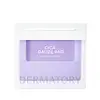What's inside
What's inside
 Key Ingredients
Key Ingredients

 Benefits
Benefits

 Concerns
Concerns

 Ingredients Side-by-side
Ingredients Side-by-side

Water
Skin ConditioningButylene Glycol
HumectantMethylpropanediol
SolventGlycerin
HumectantDipropylene Glycol
HumectantGuaiazulene
AntimicrobialChrysanthemum Parthenium Extract
Skin ConditioningChamomilla Recutita Extract
Skin ConditioningCentella Asiatica Leaf Extract
Skin ConditioningSea Water
HumectantBetula Alba Juice
AstringentChrysanthemum Boreale Flower Extract
AntioxidantGlycyrrhiza Glabra Root Extract
BleachingSodium Hyaluronate
HumectantHydrolyzed Collagen
EmollientAlthaea Rosea Flower Extract
Skin ConditioningRosa Centifolia Flower Water
Skin ConditioningHoney Extract
HumectantOlea Europaea Fruit Oil
MaskingHydroxyacetophenone
AntioxidantAllantoin
Skin ConditioningHydroxyethylcellulose
Emulsion Stabilising1,2-Hexanediol
Skin ConditioningCaprylyl Glycol
EmollientHydroxyethyl Urea
HumectantEthylhexylglycerin
Skin ConditioningTromethamine
BufferingSodium Carboxymethyl Beta-Glucan
CleansingPolysorbate 80
EmulsifyingPentylene Glycol
Skin ConditioningOctanediol
Caffeine
Skin ConditioningCarbomer
Emulsion StabilisingDisodium EDTA
Water, Butylene Glycol, Methylpropanediol, Glycerin, Dipropylene Glycol, Guaiazulene, Chrysanthemum Parthenium Extract, Chamomilla Recutita Extract, Centella Asiatica Leaf Extract, Sea Water, Betula Alba Juice, Chrysanthemum Boreale Flower Extract, Glycyrrhiza Glabra Root Extract, Sodium Hyaluronate, Hydrolyzed Collagen, Althaea Rosea Flower Extract, Rosa Centifolia Flower Water, Honey Extract, Olea Europaea Fruit Oil, Hydroxyacetophenone, Allantoin, Hydroxyethylcellulose, 1,2-Hexanediol, Caprylyl Glycol, Hydroxyethyl Urea, Ethylhexylglycerin, Tromethamine, Sodium Carboxymethyl Beta-Glucan, Polysorbate 80, Pentylene Glycol, Octanediol, Caffeine, Carbomer, Disodium EDTA
Centella Asiatica Extract
CleansingGlycyrrhiza Uralensis Root Extract
Skin ConditioningHouttuynia Cordata Extract
Skin ConditioningGlycerin
HumectantButylene Glycol
HumectantDipropylene Glycol
HumectantPropanediol
Solvent1,2-Hexanediol
Skin ConditioningEthylhexylglycerin
Skin ConditioningHyacinthus Orientalis Extract
Skin ConditioningPolygonum Multiflorum Extract
Skin ConditioningCarbomer
Emulsion StabilisingHydroxyethylcellulose
Emulsion StabilisingPolyglyceryl-10 Laurate
Skin ConditioningPolyglyceryl-10 Myristate
Skin ConditioningArginine
MaskingAllantoin
Skin ConditioningDisodium EDTA
Nymphaea Alba Flower Extract
Skin ConditioningRicinus Communis Seed Oil
MaskingBetaine
HumectantPanthenol
Skin ConditioningCitrus Paradisi Peel Oil
MaskingPelargonium Graveolens Flower Oil
MaskingMelaleuca Alternifolia Leaf Oil
AntioxidantRosmarinus Officinalis Leaf Oil
MaskingCentella Asiatica Extract, Glycyrrhiza Uralensis Root Extract, Houttuynia Cordata Extract, Glycerin, Butylene Glycol, Dipropylene Glycol, Propanediol, 1,2-Hexanediol, Ethylhexylglycerin, Hyacinthus Orientalis Extract, Polygonum Multiflorum Extract, Carbomer, Hydroxyethylcellulose, Polyglyceryl-10 Laurate, Polyglyceryl-10 Myristate, Arginine, Allantoin, Disodium EDTA, Nymphaea Alba Flower Extract, Ricinus Communis Seed Oil, Betaine, Panthenol, Citrus Paradisi Peel Oil, Pelargonium Graveolens Flower Oil, Melaleuca Alternifolia Leaf Oil, Rosmarinus Officinalis Leaf Oil
 Reviews
Reviews

Ingredients Explained
These ingredients are found in both products.
Ingredients higher up in an ingredient list are typically present in a larger amount.
1,2-Hexanediol is a synthetic liquid and another multi-functional powerhouse.
It is a:
- Humectant, drawing moisture into the skin
- Emollient, helping to soften skin
- Solvent, dispersing and stabilizing formulas
- Preservative booster, enhancing the antimicrobial activity of other preservatives
Allantoin is a soothing ingredient known for its protective and moisturizingg properties. Because of this, it is often added to products with strong active ingredients.
Studies show higher concentrations of this ingredient can promote wound healing.
Though it can be derived from the comfrey plant, allantoin is produced synthetically for cosmetic products to ensure purity.
Learn more about AllantoinButylene Glycol (or BG) is used within cosmetic products for a few different reasons:
Overall, Butylene Glycol is a safe and well-rounded ingredient that works well with other ingredients.
Though this ingredient works well with most skin types, some people with sensitive skin may experience a reaction such as allergic rashes, closed comedones, or itchiness.
Learn more about Butylene GlycolCarbomer is a polymer of acrylic acid. Its main role is to create a gel consistency.
A high amount of carbomer can cause pilling or balling up of products. Don't worry, most products contain 1% or less of carbomer.
Dipropylene Glycol is a synthetically created humectant, stabilizer, and solvent.
This ingredient helps:
Dipropylene glycol is technically an alcohol, but it belongs to the glycol family (often considered part of the ‘good’ alcohols). This means it is hydrating and gentle on skin unlike drying solvent alcohols like denatured alcohol.
As a masking agent, Dipropylene Glycol can be used to cover the smell of other ingredients. However, it does not have a scent.
Studies show Dipropylene Glycol is considered safe to use in skincare.
Learn more about Dipropylene GlycolDisodium EDTA plays a role in making products more stable by aiding other preservatives.
It is a chelating agent, meaning it neutralizes metal ions that may be found in a product.
Disodium EDTA is a salt of edetic acid and is found to be safe in cosmetic ingredients.
Learn more about Disodium EDTAEthylhexylglycerin (we can't pronounce this either) is commonly used as a preservative and skin softener. It is derived from glyceryl.
You might see Ethylhexylglycerin often paired with other preservatives such as phenoxyethanol. Ethylhexylglycerin has been found to increase the effectiveness of these other preservatives.
Glycerin is already naturally found in your skin. It helps moisturize and protect your skin.
A study from 2016 found glycerin to be more effective as a humectant than AHAs and hyaluronic acid.
As a humectant, it helps the skin stay hydrated by pulling moisture to your skin. The low molecular weight of glycerin allows it to pull moisture into the deeper layers of your skin.
Hydrated skin improves your skin barrier; Your skin barrier helps protect against irritants and bacteria.
Glycerin has also been found to have antimicrobial and antiviral properties. Due to these properties, glycerin is often used in wound and burn treatments.
In cosmetics, glycerin is usually derived from plants such as soybean or palm. However, it can also be sourced from animals, such as tallow or animal fat.
This ingredient is organic, colorless, odorless, and non-toxic.
Glycerin is the name for this ingredient in American English. British English uses Glycerol/Glycerine.
Learn more about GlycerinHydroxyethylcellulose is used to improve the texture of products. It is created from a chemical reaction involving ethylene oxide and alkali-cellulose. Cellulose is a sugar found in plant cell walls and help give plants structure.
This ingredient helps stabilize products by preventing ingredients from separating. It can also help thicken the texture of a product.
This ingredient can also be found in pill medicines to help our bodies digest other ingredients.
Learn more about Hydroxyethylcellulose